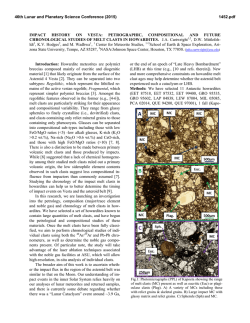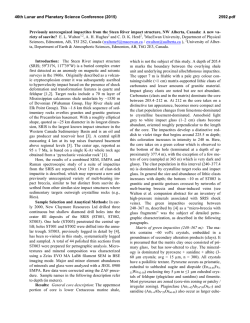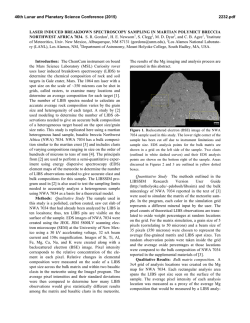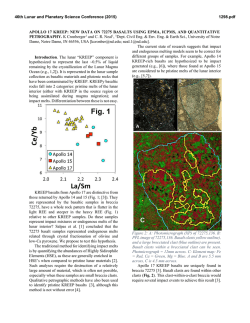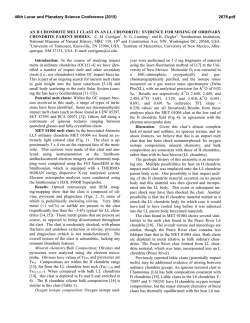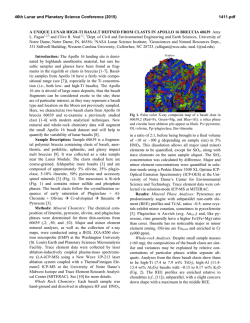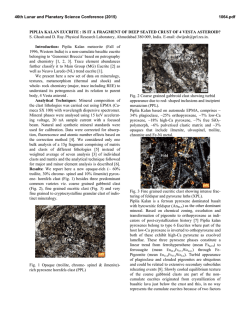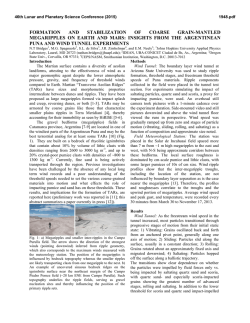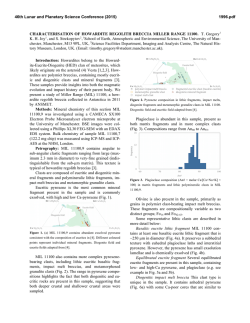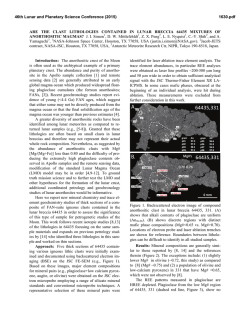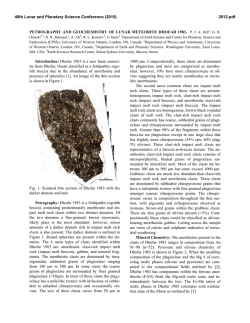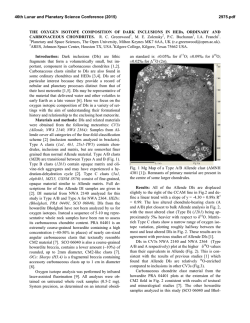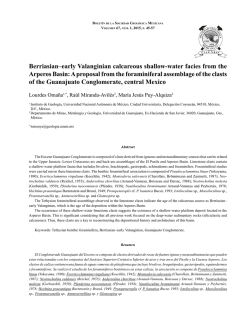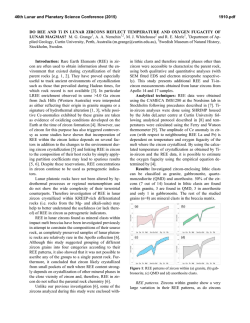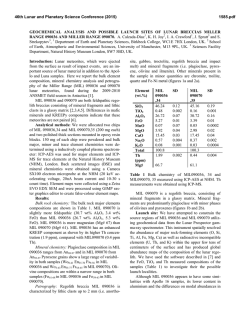
1941
46th Lunar and Planetary Science Conference (2015) 1941.pdf PETROLOGY OF IRON, TITANIUM, AND PHOSPHORUS RICH CLASTS WITHIN MARTIAN METEORITE NORTHWEST AFRICA 7034. A. R. Santos1, C. B. Agee1, F. M. McCubbin1, C. K. Shearer1, 1 Institute of Meteoritics, 1 University of New Mexico, MSC03-2050, Albuquerque, NM 87131 ([email protected]). Introduction: In recent years, data from missions and meteorite studies have shown the martian crust to contain a wider variety of igneous rock compositions than previously thought [e.g., 1-3]. Due to its nature as a polymict breccia, many examples of martian igneous diversity are found as clasts within the martian meteorite NWA 7034 and pairings [e.g., 4-5]. While the majority of these clasts are of basaltic composition, a smaller number of clasts derive from a lithology that appears unique among rock types observed from Mars. This clast group is rich in Fe-Ti oxides and phosphate (FTP clasts) [4]. They are a close analog to terrestrial FTP rocks that are associated with anorthosite massifs [6]. Several difficulties in describing this clast group were encountered in the study of [4]. Mainly, this clast group shows highly variable mineral modes between clasts, and individual clasts are typically smaller than other igneous clasts. This makes determination of properties such as the bulk composition or average mineral mode for the group difficult. Without this information, the petrogenesis of this clast type cannot be understood. The aim of this study is to conduct a thorough petrologic investigation of the FTP clast type within NWA 7034 and pairing NWA 8674 in order to better define its characteristics and to understand its petrogenesis. Methods: Mineral phases in FTP clasts were analyzed by electron probe microanalysis at the University of New Mexico to determine major and minor element compositions. Backscattered electron (BSE) images of the clasts were also acquired for textural analysis and determination of mineral modes. Bulk clast compositions were determined for two clasts using mineral modes, average mineral compositions, and average mineral density from [7]. Results: In addition to the six FTP clasts identified in [4], seven new FTP clasts were observed in this study. The clasts are composed primarily of plagioclase, Cl-rich apatite, and Fe-Ti oxides (ilmenite and magnetite). Some clasts contain Fe-sulfide (sometimes altered), alkali feldspar, pyroxene (high and low Ca), and rutile, agreeing with the initial observations of [4]. Mineral compositions within these clasts mostly fall within the range established from initial FTP clast observations, but some clasts extend the range (e.g., greater Ab contents in plagioclase). Some clasts also have greater modal abundances of magnetite (up to 4.5%) than FTP clasts described in [4]. Magnetite composition in this clast group is Sp1-6Cr0-7Uv1-19Mg7598. Figure 1: BSE images of three FTP clasts. pl-plagioclase, ap-apatite, ilm-ilmenite, mag-magnetite, ksp-alkali feldspar, sf-Fe sulfide with some alteration, mes-mesostasis. A and B 46th Lunar and Planetary Science Conference (2015) show clasts typical of this group, while C has characteristics of other igneous clasts within NWA 7034. Two new FTP clasts compositions are plotted in Fig. 2, and fall within the field of estimated FTP clast compositions from [4]. These clasts did not contain pyroxene, and their Mg#’s are 16 and 18. Fe3+/∑Fe was 0.45-0.48 in these clasts, which is higher than the initial range reported for this clast type, however the two clasts measured contain more magnetite than the previously described clasts used to calculate Fe3+/ΣFe (Fe3+/ΣFe in the bulk clasts was determined from Fe3+ calculated in pyroxene and Fe-Ti oxides). Two clasts were observed to have regions of mesostasis (Fig. 1A), distinguished from the rest of the clast by the fine grained, acicular nature of its mineral phases. The mesostasis areas are compositionally similar except for elements found in apatite and Fe-sulfide, suggesting one clast has more of these components than the other. These mesostasis regions fall away from the estimated bulk FTP clast composition field defined by [4], having a volatile free SiO2 content of ~52 wt%. Discussion: Based on differences in texture, mineral abundances, and bulk compositions, FTP clasts were interpreted to represent a distinct lithology from the other igneous clasts found in NWA 7034 by [4]. The new observations from this study support this interpretation. It is unclear at this point, however, if all of the FTP clasts originate from a single igneous lithology. A statistically significant population of this clast type, along with trace element abundances in individual phases within FTP clasts, is needed to better address this question because properties such as mineral mode 1941.pdf (and therefore clast bulk composition) can be highly variable in this clast group. The discovery of a clast containing a mixture of properties of FTP clasts and basalt clasts suggests there may be a lithology with properties intermediate between the FTP clasts and basalt clasts, and may provide a link between the clast groups. The FTP clasts show similarities to other Fe, Ti, and P rich rocks from Earth, but it is unclear at this time if they formed from similar igneous processes (e.g., in relation to anorthosite massifs, 6). There is still debate over formation mechanisms for these lithologies on Earth, with possible formation mechanisms including silicate liquid immiscibility, assimilation-fractional crystallization, and crystal accumulation [6]. We will continue to examine these clasts within NWA 7034 in this broader planetary context to shed light on their petrogenesis, as well as that of FTP rocks from other bodies. The unique composition of these clasts likely requires a petrogenetic mechanism that has not been thought to be common for martian igneous rocks. Understanding the broader petrologic context of this lithology on Mars is important with respect to martian geochemistry, as this lithology is likely a host to high concentrations of incompatible elements compared to typical martian rocks due to the high modal proportions of apatite in clasts (up to ~30%). The age of this lithology is the least well constrained of any of the NWA 7034 igneous clasts (zircons were not measured in any of these clasts, and they do not contain large amounts of pyroxene, see [9]), but it is likely they are also ancient. If this proves to be true, this lithology could be evidence of a highly geochemically enriched crustal component that was present on Mars for billions of years, although it is unclear at this time what crustal depths are required for formation of the FTP lithology (i.e., crystallization at the surface/shallow subsurface may be necessary). References: [1] Stolper E. M. et al. (2013) Science, 341, 7. [2] Bruckner J. et al. (2003) JGR Planets, 108, 8094. [3] Gellert R. et al. (2006) JGR Planets, 111, 32. [4] Santos A. R. et al. (2015) GCA, in review. [5] Humayun M. et al. (2013) Nature, 503, 513-516. [6] Owens B. E. and Dymek R. F. (1992) Can. Min., 30, 163-190. [7] Deer W. A. et al. (1992) Figure 2. TAS diagram of [8] showing clast compositions from NWA 7034 and pairs. Microbasalt and CLIMR from [5], FTP clasts and FTP clast mesostasis from this study, all other data from [4] Intro to Rock Forming Min., New York. [8] Cox K. G. et al. (1984) Interp. of Ig. Rocks, London. [9] Nyquist L. E. et al. (2013) 76th Met Soc., Abstract #5318.
© Copyright 2024
